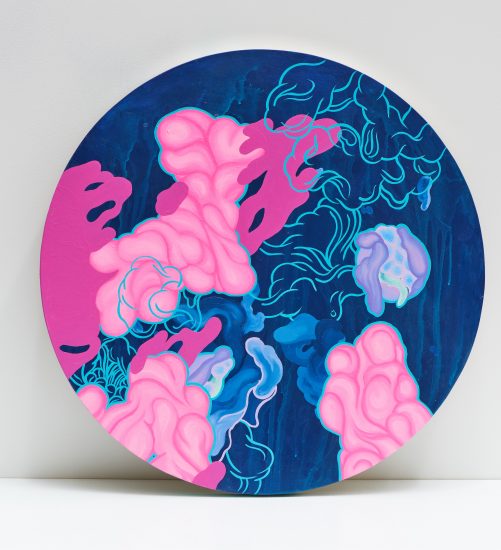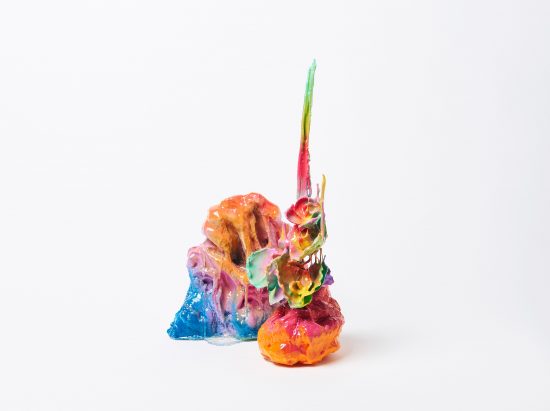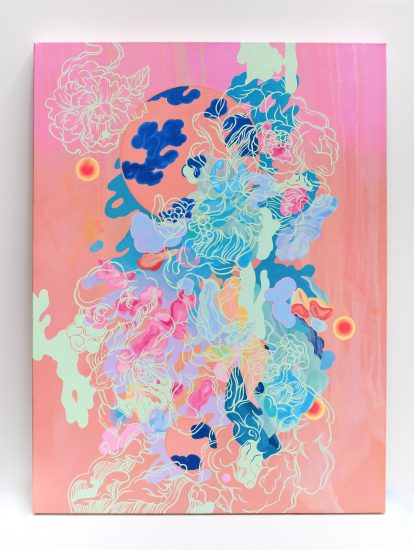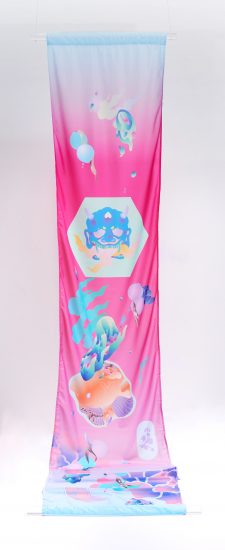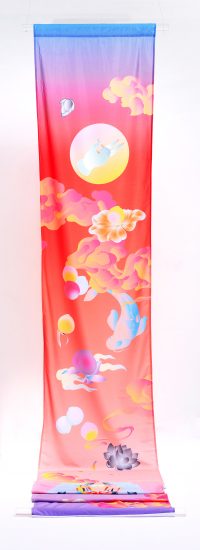Louise Zhang talks to Art Life editor Andrew Frost about the process behind the new suite of works in her latest exhibition, Art World Eats Its Young…
Louise Zhang, In Hell we… [detail]. 2018 Oil and acrylic on wood, 50 cm diameter. Courtesy: Artereal Gallery
Andrew Frost: Let’s talk about the title for your latest show, Art Eats Its Young. It seems like it could equally be about the kind of dedication it takes to develop works like these, as much as it is about your position in the art world! What’s it about?
Louise Zhang: I’m glad you caught that! The title actually came from a conversation with a friend, writer, artist and curator Pedro de Almeida about something regarding the art world — “Art World Eats Its Young!”. I thought it was fantastic as it certainly feels true to me …in a laughably sad sort of way. However, that meaning quickly shifted to a memory to when I was a teen when my parents thought a lot of my issues were the result of too much “art thinking” (over thinking and questioning things that usually wouldn’t be questioned making me overly anxious). It’s pretty funny now but my parents were very worried about me. With art being such a significant part of my life, it understandably was one of the things they thought was unhealthy for me when they didn’t know what was going on with me … And that’s how it became the title of the show as the works became a reflection of my relationship with art, family, mental health and religion.
Louise Zhang, The Devils Crayons #1-9, 2018. Polyurethane, resin, spray paint, acrylic paint, foam clay, synthetic flowers
23 x 25 x 21cm. Courtesy: Artereal Gallery
AF: You’ve had a long-standing interest in horror and the monstrous, but equally in idea of attraction and allure in colour and form, sort of kawaii meets the abject. How has this idea developed in this new body of work?
LZ: My previous work dealt quite specifically to the monstrous and “cuteness” as concepts on there own. They are still heavy vehicles for what I create, but as I slowly come to terms with my family and more importantly my identity, I’ve asked myself why these things interest me so. Growing up within the Christian faith, as a Second generation Chinese-Australian, the bits that were scariest in the Bible were the bits I found most fascinating (Hell!) and the confusion of not understanding so many Chinese traditions, stories and rituals despite being Chinese as a result of this faith BUT being told being Chinese came first was like a movie moment where everything explodes and no one escapes. Hell was s a real fear of mine as I struggled with my interests and ideals versus what I taught. (It’s only natural to be intrigued by things that are forbidden to us right?) The monstrous is explored through understanding an alternate perspective of Hell that’s tied to my heritage than to the Western notion of Hell I was taught. Colour and “kawaii” become tools of seduction to understand these aspects.
Louise Zhang, The Pure Land, 2018. Oil and acrylic on canvas, 102 x 76cm. Courtesy: Artereal Gallery
AF: I’m really interested in the large paintings you’ve produced, works such as Hungry Ghosts, The Pure Land and Sinners Into Fragments. They feel like they’re engaged in a more explicit way than perhaps past works with elements of traditional Chinese painting.
LZ: YES, I AM CHINESE!!! I have up until recently felt a pressure to not directly bring my personal experiences into my work as I didn’t want to become “another second generation artist dealing with identity” (not like that there’s any issues with that!). There’s so many of us. But I was misunderstood and took pride in comments made to me — “You are Australian. Chinese is just part of you but YOU ARE AUSTRALIAN.” Now I understand my pride was misplaced because being Chinese was an embarrassment. I went to residencies in China, Beijing and Chongqing, to learn more about mainland Chinese horror but realised my interested where actually in hell. A lot of the imagery comes from ancient Chinese and Japanese illustrations of hell as well as from time spent at the Beijing Dongyue Temple – Temple of the Eastern Peak.
AF: One aspect I find really intriguing in the paintings is the way you create a sense of layering through colour and line. Is there a lot trial and error in making the paintings, or do you plan them out?
LZ: There is a tonne of trial and error in these paintings. I try to plan them out but ultimately, like with these works, it never pans out. Instead, I draw from sketches I’ve done, books and the good ol’ internet for references.
Louise Zhang, Soft Horror #5, 2017. Digital print on polyester, acrylic rod,140cm x 57cm. Courtesy: Artereal Gallery
Louise Zhang, Soft Horror #4, 2017. Digital print on polyester, acrylic rod, 140cm x 57cm. Courtesy: Artereal Gallery.
AF: I’ve seen some older pieces that you’d done using digital processes rather than painting or drawing, and the new hanging works feel like they have a direct connection to them, certainly in the kinds of colours and motifs. Could you talk a bit about the process of developing and making them?
LZ: The first time I’ve really played with the digital is when I had this weird obsession with PowerPoint and spent a lot of time in there making works called “Flailing Forms”. When it became too restrictive to narrate what I wanted to create (my computer couldn’t handle all the PP layers), I moved to Illustrator, however, these works are all informed by my time with PowerPoint. The hanging works are developed from sketches. I then scan them and draw them in with a stylist. Instead of drawing a wholly “finished” piece, I like to draw different elements in and then piece them together in Illustrator, moving them around, changing colours etc and see what happens. It’s quite fun actually.
Louise Zhang, Art Eats Its Young, Until June 2, Artereal Gallery, Sydney
